When you think of the brands killing it on social media, the first few that come to mind are probably B2C companies (business to consumer). You rarely hear about the IT management company that’s crushing it on Twitter, or the granite manufacturer that’s dominating Instagram. But these types of B2B companies exist. The problem is they’re in the minority.
For some reason, a lot of B2B companies have either struggled to grasp social media marketing or flat out ignored it. Despite the success that B2C companies have seen with social media, B2B companies still rely on traditional tactics like cold calling and attending business networking breakfasts. Those tactics are effective, but they shouldn’t be used in place of social media.
Instead, you need to integrate social into your strategy for even better results.
If you’ve been shying away from Twitter, Facebook and Instagram because you think it won’t work for companies that serve other businesses, you’re missing out on a huge opportunity. Here’s how to create a B2B social media that will grow your brand and earn leads:
Jump to the B2B Social Media Strategy Infographic.
The Biggest B2B Social Media Marketing Myth
You’ve probably heard this at some point, or even thought it yourself. Social media won’t work for me because I’m in a “boring” industry.
Erase that thought from your mind completely. Social media is not reserved for clothing and beauty companies. There are more than a billion people around the world on social media. You can bet that at least a small percentage of them are interested in your industry.
Your job is to find them.
One of the best examples of a B2B company in an industry that might be considered boring, but is rocking social media, is Novartis, a pharmaceutical company in Switzerland.
Most people wouldn’t expect a company in this industry to be on social media at all, yet alone have any level of success. Surprisingly Novartis has built a strong presence on Instagram, without posting hundreds of selfies and inspirational quotes. Instead, you’ll see visuals like this:
The key is to think about the type of content that your audience will like, rather than being self serving.
For instance, the insurance industry is about as uninteresting as it gets for most people. Sharing links about how to choose business insurance all day isn’t going to build a following. But when you think about who is your your likely audience and tailor your social media content toward those people, the scope of what you can post becomes a lot wider.
In this case, the target audience is business owners. Hiscox offers insurance for small businesses. If you look at Hiscox’s Facebook page, you’ll find posts about business financing, marketing and entrepreneurship. These are topics that Hiscox’s audience resonates with, and the content can actually benefit them even though it isn’t all about insurance.
Make social media about your audience, not just your business. That way, even if you’re in a “boring” industry, you can still deliver share-worthy content on social media and continue to build your audience.
A good way to tell whether or not you’re sharing great social media content is to ask yourself this: If I didn’t work for this company, would I look at this post?
If the answer is no, it’s a sign you need to revamp your content.
Getting Started With B2B Social Media Marketing
Ok, so now that you’ve bought in to the idea that social media works for B2B companies, the next question is how do you get started?
You might be eager to just jump right in and start posting on Instagram and Facebook. But first, let’s take a step back and plan things out a bit.
Decide Your Goals & What to Measure
First and foremost, what’s going to determine success for your brand on social media? Do you want to increase reach? Get more leads? Generate more traffic to your company blog?
The answers to those questions will help you decide which metrics to measure. And they differ depending on the social networks you use.
For instance, if you’re trying to increase reach, you might track:
- Organic reach
- Paid reach
- Impressions
- Engagement
- Follower count
If your goal is leads, then you’d look at metrics like:
- Clicks
- New leads from social media
- Conversions
Once you know your goals and how you’re going to measure them, make sure you get a social media analytics platform to help you track it all. The last thing you want is to rely on spreadsheets and manual tracking.
In order to get a 360-view of how your B2B social media marketing efforts are going, you can use Sprout’s social media analytics suite.

Sprout makes it easy to measure your social performance across Facebook, Instagram, LinkedIn and Twitter.
If one of your primary goals and metrics is leads, then you can also check out our advanced analytics with Simply Measured. This will allow you to attach a value to all the traffic you’re getting from social, so you can track that oh-so-elusive social media ROI.
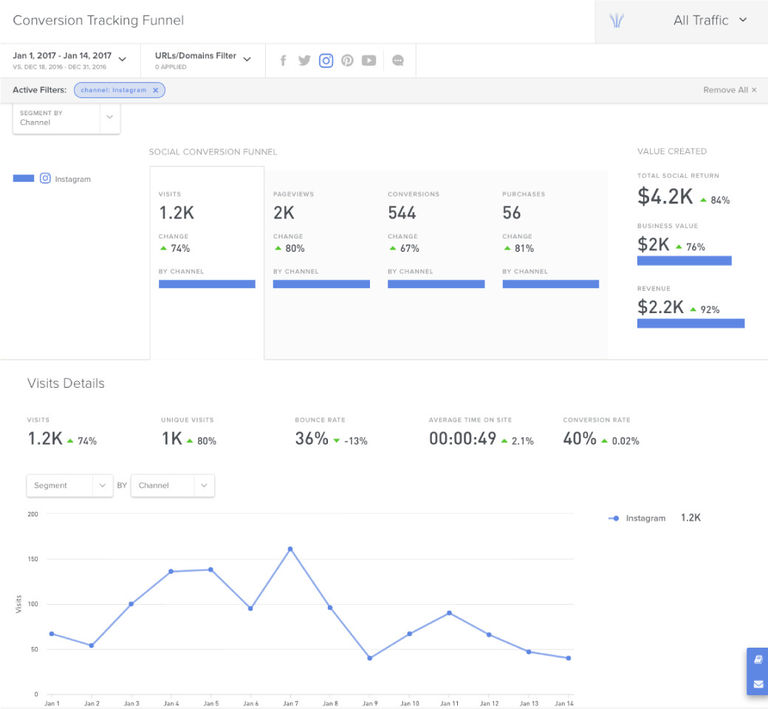
Create a Written Strategy
You know what you want to accomplish on social and how you’re going to measure success. The next step is laying out the steps for how to get there.
Don’t worry if your company doesn’t have a plan in place yet. You’re not alone.
Although 80% of B2B marketers have a social media strategy, only 32% have it written down somewhere.
Documenting your B2B social media plan allows you to set goals and paint a clear roadmap of how you’re going to reach them. Your strategy should answer important question such as:
Having all of this documented keeps everyone on the same page, and allows you to adjust your strategy when you need to. Check out our seven step social media strategy for tips on how to create your own plan for success.
Best Practices for B2B Marketing on Social Media
Any brand can create social media profiles and post a few Tweets or Instagram photos. But not every brand can plan and execute a social media strategy that gets results.
All too often we see B2B companies fall flat on social media. They don’t generate any engagement and scrolling through their feeds is about as exciting as watching paint dry.
So how can your brand avoid falling into the same pitfalls so many B2B companies are lost in? Follow some of these best practices:
Create A Personality
Being boring and dull on social media is a good way to fail.
Unfortunately, since a lot of B2B companies treat social media as an afterthought, their posts lack personality and a human touch.
The fear of being too edgy or controversial keeps some B2B marketers from getting creative with their content. And we get it, not every brand can (or should) pull off a sassy tone on social as well as Wendy’s.
However, you don’t have to be a Twitter troll or go over the top to be entertaining. There’s a big difference between Tweeting offensive jokes and just sounding like an actual human instead of a robot.
You can develop a social media voice without being inappropriate and making headlines for all the wrong reasons.
Here are some tips to get started:
- Use a conversational tone. Your company can be its own entity. For instance, you can use words like “we” and “our” when you’re speaking about your company.
👍 We’re very excited to be a part of this incredibly valuable collaboration!
— IBM (@IBM) April 16, 2018
- Engage with other users instead of just broadcasting your message. Social media is all about conversing and being able to have real-time conversations. Don’t be afraid to talk to your audience (whether they’re angry or happy) through your social media platforms.
- A little humor is always welcome. Social media wasn’t created for businesses, it’s for humans. Social networks are where people can have fun, share content and converse. So why not let your hair down a bit with your social media content? Just make sure not to go over the top.
Nobody wants to deal with boring, faceless corporations. Use social media as a way to humanize your brand. Follow in the footsteps of B2C companies and add some spunk and flavor to your social media to connect with your audience.
Don’t Restrict Yourself to Just LinkedIn
Wait, what? We’re telling you not to use the most effective B2B social media platform? Before you think we’ve lost our minds, keep reading.
LinkedIn has developed a reputation for being the top B2B social media platform for these companies, and it makes sense. Content Marketing Institute found that 63% of marketers rated LinkedIn as the most effective B2B social media platform.
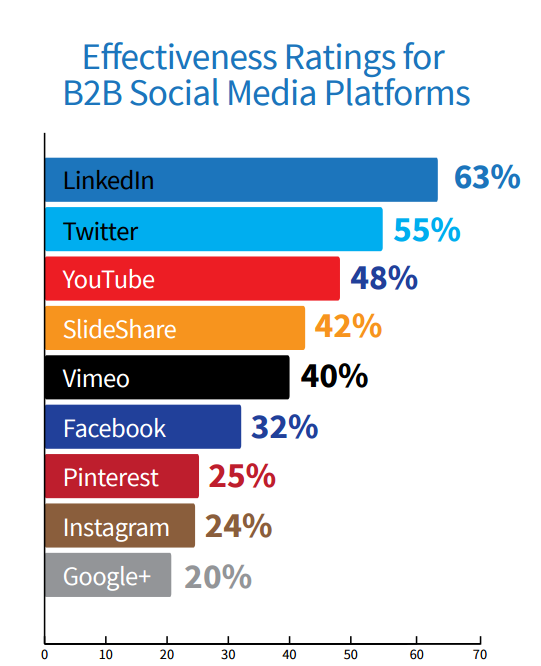
As a result, a lot of B2B marketers feel they need to be on LinkedIn and nothing else.
The reason behind this is they’re looking at social media strictly as a way to generate leads, which makes LinkedIn appealing. However, your first goal of B2B social media marketing needs to be branding, not leads.
While your inner-marketer might be telling you social media is all about selling products, that’s far from the reality.
Most people are on social media to be entertained and kill some time, so your social media content needs to appeal to that. That means instead of posting a bunch of Instagram videos about why your products are so great, follow in the footsteps of Salesforce and create content that tells stories, appeals to emotion and sparks conversation.
When you think of social media with this new-found perspective, it opens up the possibility of which social media platforms you can choose beyond LinkedIn. All of a sudden Instagram and Pinterest are no longer off limit.
Social Media Examiner found that more B2B companies are starting to pick up on this and are expanding beyond LinkedIn.
- 89% of B2B marketers use LinkedIn
- 88% use Facebook
- 83% use Twitter
- 61% use Google+
- 55% use YouTube
- 39% use Pinterest
- 26% use Instagram
The companies on Instagram, Facebook and other platforms that aren’t traditionally used for B2B marketing realize the importance of using social media for branding instead of just looking for leads.
A perfect example of this is the commercial real estate company CBRE. If CBRE saw social media as a way to just generate leads, it would put all of its effort and resources toward LinkedIn.
However, the company branched out and recognized how beneficial social media can be for branding, and started utilizing other platforms like Instagram, Twitter and Facebook.
One of the best ways to find other social media platforms besides LinkedIn for your B2B company is to see what your competitors are using to successfully build an audience. Finding them is easy, since most businesses have links to their social media profiles on their website.
Take a look at the top companies in your industry and see which platforms they’re dominating. That will give you an idea of where to start.
You can also take a look at these social media demographics to find out where your audience hangs out. Despite what you may have heard, LinkedIn isn’t the only social network for B2B companies.
Put the Right People in Charge
This could mean hiring a social media manager or having a current employee take the helm, but someone has to be in charge of your social media marketing. It’s not something you can just have different team members participate in when they have some free time.
When you’re hiring a social media manager, look for someone with a social media marketing background, not just someone with knowledge of your industry. Talented social media marketers will learn the ins and outs of your company and industry. Forcing someone who doesn’t have a passion for social media marketing into the role of a social media manager can result in a lot of struggling.
If you’re not ready to invest in a full-time social media manager quite yet, you can also consider working with a freelancer. Sites like Upwork or Freelancer.com are good places to look.

B2B Social Media Marketing Tactics
Ok, so by now you’re thinking “that all sounds good, but how can I actually put this into action?”
You want tactics and real-life strategies. We get it. So let’s take a look at some battle tested B2B social media tactics that work:
Employee Advocacy
You’ve probably been hearing about employee advocacy more and more in the last couple years. With all the algorithm changes, brands are constantly looking for ways to get more eyes on their social media content. That’s where employee advocacy comes in handy.

Employee advocacy is all about giving your employees the ability to champion your brand to their own circles. For instance, if your company creates blog posts, infographics and videos, make it easy for employees to share that content on their personal profiles.
Traditionally, B2B brands stick to sharing content from the company social media profiles. However, that limits your reach to just your own audience.
But imagine if 10, 20 or even 100 of your employees also started sharing your content. Not only does it increase your potential reach, but it also results in more engagement.
In fact, people are 16 times more likely to read a post from a friend about a brand than from the brand itself.
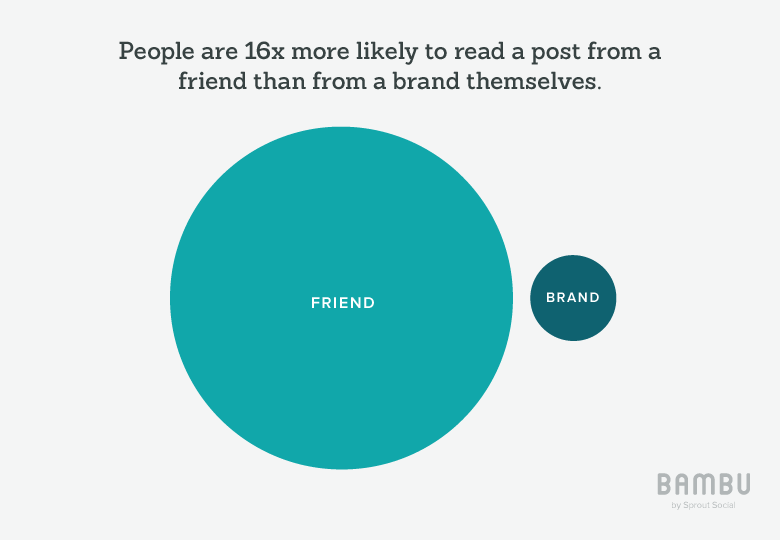
Unfortunately, getting employees to share your brand’s content isn’t as simple as just asking.
Think about it. They have find the content on your site, login to their social media accounts, write copy and share it. And while that doesn’t eat up a ton of time, it’s inconvenient.
That’s why we created Bambu, an employee advocacy platform that makes it extremely simple to get your team to share your content. You just curate the content you want them to share, write out ideas for the copy of their posts and they can publish it directly from their profiles. They can even schedule the posts to publish later if they want.

Plus you can use the reporting features to see which content performs best and the overall impact employees have on your brand’s social presence.
Check out this handy calculator to see how much potential reach you’re missing out on by not using employee advocacy.
Learn the Art of Social Selling
We’ve established that leads shouldn’t be your primary focus of using social media. However, it’s still very important to make sure your social media efforts are paying off, particularly for B2B companies. That’s where social selling comes into play.
Social selling is using social media to introduce prospects into your funnel.
To be clear, it’s not hard selling or cold calling. However, it’s much more powerful when done by individuals rather than from your brand’s social media profile.
The goal is to find people who could benefit from your product, and build a relationship with them through providing helpful content and value. You’re not just Tweeting a link to your product every time someone mentions they have a problem.
Here’s an example of how Ahrefs founder Tim Soulo interacted with a new customer testing out the software. Opportunities like these are great to engage with your audience and teach them about your product without being a pushy salesperson.
very hard question.. Too many cool features to pick a favourite one 🙂 Check out this video about Content Explorer: https://t.co/kAh8Fm3vcp
— Tim Soulo (@timsoulo) April 9, 2018
The buying process has changed significantly thanks to social media, and B2B companies are not immune. Today, buyers don’t need companies to reach out to them to discover new products and services. They’re conducting 90% of the purchasing process on their own.
They’re looking at reviews, Googling solutions for their problems and finding out about new companies through social media. In fact, 55% of B2B buyers search for information on social media. Often times, by the time they talk to an actual sales person, they’ve already made the decision to try your product.
Another reason why social selling is beneficial for B2B companies is because there are so few brands doing it. Most B2B brands are relying on outbound tactics like cold calling and direct mail. Building your presence on social media sets you apart from the competition.
Although LinkedIn is the clear standout for gaining B2B leads on social media, Facebook and Twitter are also being used to generate leads as well. Here’s a breakdown of B2B leads generated through social media.
- LinkedIn: 80%
- Twitter: 12%
- Facebook: 6%
- Google+: 0.21%
Again, that doesn’t mean that you should put all of your focus on LinkedIn marketing just because it can earn the most leads. There are other benefits of social media that aren’t as measurable, such as brand loyalty or the trust you build with a potential buyer from sharing valuable content on Twitter and Facebook.
Curious about how well you’re doing with social selling? LinkedIn’s Social Selling Index shows you a score based on four elements of social selling:
- Establish your professional brand
- Find the right people
- Engage with insights
- Build relationships
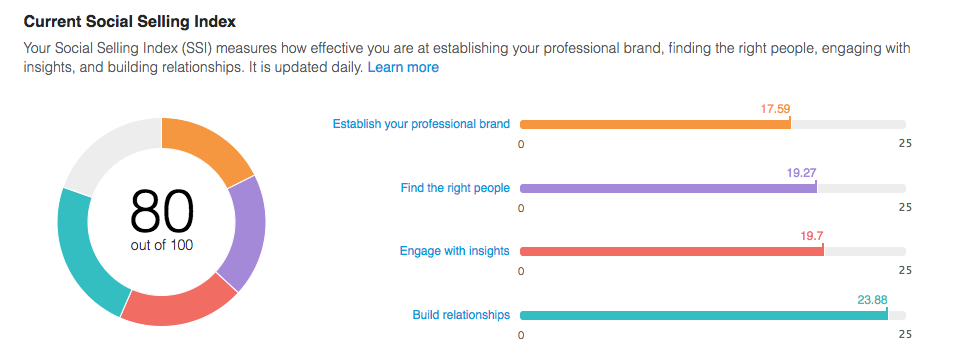
Take Advantage of User Generated Content
When you think of user generated content, your first thought is probably people posting photos with the latest detox tea on Instagram. We’ll be the first to admit getting UGC is a lot easier when you sell consumer goods, but that doesn’t mean B2B companies can’t get in on the action. And we’re living proof.
We sell social media management software. So people aren’t exactly rushing to Instagram to post screenshots of our product in action. But we’ve found other ways to connect with our audience and get them to share visuals of our brand on social media.
Whether it’s new customers, our All Stars or agency partners, we love sending out free swag and gift boxes to show our appreciation. In addition to building relationships, customer retention and giving thanks, it also results in some great user generated content from our community!
We ask our customers and followers to use the branded hashtag #sproutlove when sharing content about our brand, which makes it easy to search for our social team to find UGC. Then we use the Smart Inbox to see the latest social media posts using the branded hashtag on social. That way, we can quickly reply and return the love.
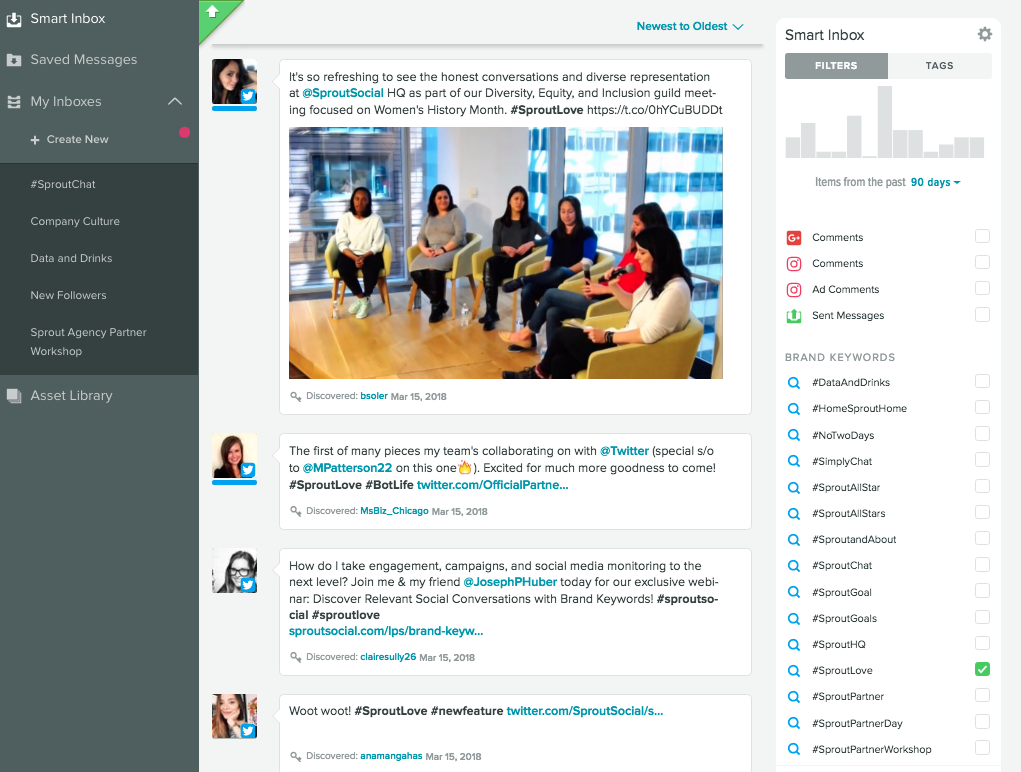
In addition to sending swag to your audience, you could also host events and have attendees share photos on social. Or you could run a contest and ask customers to post about their experience with your brand.
WeWork is another B2B company that does a great job of integrating UGC into their social strategy. A bulk of the WeWork Instagram feed is photos posted by customers at their co-working spaces.
Think of creative ways to get your audience to post about your brand on social. Not only will it help you fill your social media calendar, but it’ll help you grow an engaged community as well.
Are You Using B2B Social Media Strategies for Your Company Yet?
We’re no longer at a point where you have to question whether or not social media works for B2B companies. That has already been proven. Now, you have to figure out how to make it work for your business. If you haven’t been using social media marketing, you’re already behind. It’s time to hop on board start using social media to grow your brand and get leads.
